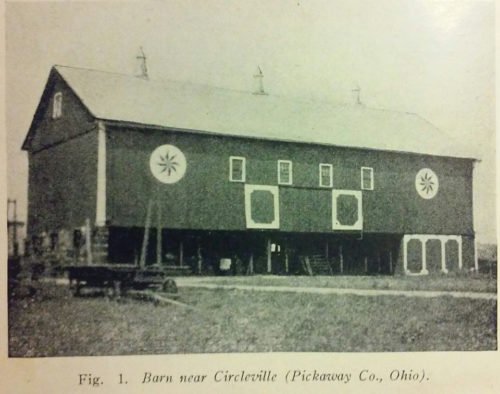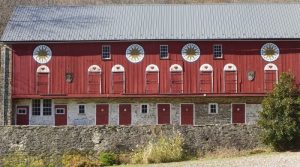The Ancient European Roots of Pennsylvania Dutch Barn Symbols

READ MORE AT RENEGADE TRIBUNE
By August C. Mahr (1945)
ON A GREAT NUMBER of Pennsylvania Dutch barns, there are geometrical ornaments painted on the outside walls; ornaments which, as a rule, show some sort of star within a circular disk (Figs. 1, 2, 8, 10b).
The Pennsylvania Dutch barn in question is of the so-called Swiss bank-barn type. It means that it is erected along an embankment in such a way that its main entrance door leads to the heavily planked floor of its wooden upper story. This floor is at the same time the ceiling of the lower story formed by the stone base structure which contains the stables for the livestock and is accessible through the doors on the lower level of the slanting terrain. As a rule, the barn, in its full length, carries a wooden fore-bay which projects from the upper story and overhangs the outside wall of the stables to the extent of about six to eight feet. Frequently, however, the barn is built on ground level with a ramp leading to the upper story. In Pennsylvania as well as Ohio, these barns are usually red, often with white arches over the white-framed fore-bay openings. Wherever barn symbols are found, they are painted in various colors on the fore-bay, or the back, or the gable sides, or on all four walls of the wooden superstructure.

The key-point is that the Pennsylvania Dutch farmers, particularly in Berks County and its neighborhood, always have been, and in many respects still are, not merely farmers but peasants in the best European sense. Not everyone who tills the soil and raises livestock is a peasant. Whereas the mere farmer’s activities are based on cold empiric facts that may be learned in agricultural schools, the peasant’s life is governed by fixed customs, if not ritual, peculiar to his particular group and origin. These customs attend all his chores in the fields, in the cattle-barn, in the house, and rule his domestic relations, his dealings with his fellows, his dress, his habits of eating and drinking, his recreations, in short, every step of his earthly pilgrimage from the cradle to the grave. Most of these rules and customs reach down into times immemorial. They contain many taboos that today are no longer obvious, and they include innumerable symbolic actions and signs traceable to prehistoric magic as well as to pagan mythology and ritual.
The Pennsylvania Dutch are quite unique in this country, in that they have tenaciously clung to a great many of the peasant traditions which their ancestors had brought with them from the Old Country. […]
This adherence of the Pennsylvania Dutch, for more than two centuries, to the native peasant customs of their German forefathers can only be explained by the fact that they did not lose their original group consciousness after they had settled in America. Instead of being readily absorbed by the new environment, as were the countless individual settlers from other German, and non-German, peasant communities of Europe, the Pennsylvania Dutch possessed in the peasant traditions of their old homeland a cultural force that was sufficiently strong to shape their new environment into a peasant community of distinctive character. In achieving this, they were substantially aided by a very happy coincidence: the amazing similarity between their old homeland and Pennsylvania. This similarity not only extends to the physiognomy of the landscape but also to climate and soil conditions. There is hardly a region in the Keystone State, which has not an almost exact counterpart somewhere in southwestern Germany. Such exceptionally good fortune allowed them to continue in their new home, with a minimum of adjustments, where they had left off in the Old Country. Nothing, in the new environment, was so essentially different as to estrange them from their native peasant views and practices.
The barn symbols here discussed occur in America exclusively with the Pennsylvania Dutch peasantry. Hence one may expect some light on their origin and significance from analogous occurrences in German peasant art which, like the peasant art of any part of Europe, is a depository of prehistoric and pagan values otherwise long obliterated.
There is ample evidence that these various symbols that occur in European peasant art, inclusive of the Pennsylvania Dutch area, have their origin in a Cult of the Sun that during the Bronze Age was practiced ‘in Ireland on the west and throughout the greater part of Europe.’
The most careful and methodical exploration of Bronze Age sites, throughout the entire European continent, over many decades, has proved that ‘the Sun Cult must have been in honor throughout Europe for at least 1,500 years, and was consequently one of the most enduring religions the world has known.’

Beyond being graphic representations of the powers venerated, the symbolic signs in practically every known religion that possesses such, are widely used for magic purposes. The people carry them on their bodies as protective amulets, they apply them to their houses, stables, and barns, furniture and household utensils, either to ward off evil influences or to enlist the aid of beneficent powers in securing fertility and good health for themselves, their livestock and their crops. This being true today, in Christian countries, it must have been even more so in prehistoric times when religion and magic were one and the same.
[…] Once a design has acquired the quality of symbol, this quality inevitably functions as the vehicle by which the design as such is carried from place to place. This elemental interrelation remains constant, regardless of modifications that both the symbolic meaning and the design itself may have undergone during their wanderings throughout the ages. It also explains why today these designs are promiscuously and interchangeably applied as propitious symbols, while their original function, magic or ritual, has long been obliterated or, at best, can be but vaguely discerned through the veil of time.
No matter what amount of migration and political re-grouping has taken place on the continent, during the Early European Iron (Hallstadt) Age and the subsequent eras of history, the ancient symbols have continued in use among the European peasantry, up to this day. This proves indirectly that all participants in such migrations and political re-shufflings, invaders and invaded alike, possessed the identical sub-stratum of magic concepts and were unaffected by subsequent religious creeds […] successively superimposed upon them. It is still in this magic sub-stratum, unchanged throughout the ages and apparently unchangeable, that even today all popular credences are rooted. For the validity of this statement it matters not what magic is used, but that magic is used.
Figure 4 represents a gold pendant with many-pointed stars, probably used as an amulet. It was found, by Schliemann, at Mycenae, and it is to be dated at ca. 1,550 B.C. Of the same provenience, date and magic function, is the gold-foil ornament shown in Figure 5, whose design is the ‘six-petaled flower-star’ so familiar to all students of folk art.

Evidently [both] of these star-like designs are symbols of the sun. It appears that [both] of them, especially the latter, secondarily and much later, acquired some bearing on fertility, for they are almost universally found, alone or in combinations, on peasant utensils pertaining to the care of livestock, in particular, of horses (Figs. 6 and 7).


The connection of the sun symbol with the horse is primary, that with other livestock, secondary and by analogy, as it were. Danish and Irish Bronze Age findings prove that the horse itself figured as a symbol in this early Sun Cult. In Denmark there was discovered ‘an engraved bronze disk six inches in diameter, covered with gold foil, mounted on a wheeled carriage drawn by a horse.’ Similar disks found in Ireland show a design almost identical with that on the Danish disk. ‘The date of this sun chariot is about 1,300 B.C. The Irish disks have lugs on the margin exactly as in the Danish specimen, the lower one for fastening it to the axle and the upper one for holding the reins.’ The discovery of two more horses, fragments of a ceremonial carriage, and of another sun disk prove beyond a doubt the age-old connection of the horse with sun worship, later fixed in the familiar Graeco-Italic myth of the sun god traveling across the sky in a chariot drawn by horses. …The persistent occurrence, in European peasant art, of sun symbols in connection with horses shows the enormous surviving power of the primeval concept.
[The Sun Cult’s] symbolic ‘astral representations, especially the solar disk or forms derived from it’ have been continually used for magical purposes from the earliest times to the present day.
The frequent combination of the ‘six-petaled flower-star’ with some other solar symbol on European peasant utensils pertaining to horses and cattle is also found on a number of Pennsylvania Dutch barns, as is shown in Figures 8 and 10b.

Similar combinations also occur, all over Europe, on various kinds of objects used by the peasantry in the processing of flax and wool, in the spinning and weaving of linen, in the making and laundering of linen goods, particularly on distaffs, weaver’s tools, mangling boards, laundry beetles, etc., and they are even found in the patterns of lace (Figs. 9a, b, c).

Evidence for the prehistoric connection of magic sun symbols with spinning is found in the occurrence of the swastika, both angular and curved, on a great many spinning whorls unearthed by Schliemann on the site of ancient Troy (3rd and 4th city).
Besides, the above-mentioned combination of symbols is frequently used on cradles, beds, salt containers, spoons, spoon racks, and other implements of the peasant household.
The heart-shaped figures, occasionally combined with any of these symbols, may belong to a later stratum of symbolism, although certain heart-shaped ornaments do occur on ancient Cretan pottery.
The ‘six-petaled flower-star,’ evidently as a pre-Christian sign of immortality, appears as the predominant symbol on grave-posts in Bosnia.
In some parts of the Old Saxon region (Niedersachsen, Germany), stars, in combination with other symbols, are frequently painted on, or carved into, the frames of barn doors (supra, Fig. 11a).

Also with the Pennsylvania Dutch, these symbols, apart from their use as barn signs, are applied to all kinds of utensils of the rural household.
Another symbol used by the Pennsylvania Dutch, both on barns and otherwise, is the swastika; not, however, the familiar, angular, form but the swastika with curved club-shaped arms such as found on a barn at Wescoesville (Lehigh County) (Fig. 10a). Another barn, about one mile south of Wescoesville, on the road to Macungie, shows a variant: instead of all four arms bending in the same direction, here both the upper and the lower pair of arms are curved towards each other (Fig. 10b). Although this modification of the symbol is likewise of great antiquity, it may be regarded, in the present case, as merely a local variant. That is all the more likely since other variations which are purposely fanciful also occur as barn symbols in southeastern Pennsylvania.

On a clay vessel (Middle Minoan I, ca. 2,100 B.C.) there occurs the curved swastika (Fig. 12).

[The swastika occurs] on a modern wooden stamp, from Brittany (France), used for the marking of consecrated bread (Fig. 13). The design, far from being Christian, is a swastika-like symbol found, in basically the same form, on a Cretan vessel (Middle Minoan II, ca. 1,800 B.C.) (Fig. 14).


A striking similarity, that can hardly be called accidental, prevails between two swastika designs, both on sword pommels, the one from Mycenae (Fig. 15a), the other from a Bronze Age deposit in Denmark (Fig. 15b).

The very same tendency in design appears in a symbolic rock sculpture of the British Bronze Age, near Ilkley, in Yorkshire (Fig. 16). Its ‘winding band’ character reveals its connection with the ornamental style demonstrated in Figures 15a and 15b.

There are strong indications that the people who made this rock sculpture were Celts of the Goidelic dialect type. Moreover, it was in Celtic-speaking Brittany that the bread stamp with that swastika-like symbol was found which has been discussed above. Further, the region about Herford, in Westphalia, where the curved club-armed swastika prevails, represents, in its peasant houses, a much older, almost purely Celtic, type than those of the surrounding Saxons. There is other evidence that this region about Herford is to be regarded as an enclave with a Celtic past in the otherwise Saxon area. This permits the inference that the curved club-armed swastika symbol was especially cultivated by Celtic people. Such an assumption is strengthened by the fact that Celtic ornamentation, as a whole, from the late Bronze Age onward, for centuries favored the swastika and related patterns, and, in their delineation, showed a tendency toward curved, bulging, designs with club-shaped terminations (Fig. 17).

The universal occurrence of these age-old designs as propitious or magic symbols among the European and, in particular, the German peasantry naturally makes it impossible to determine by which of the various German groups that constitute the Pennsylvania Dutch any given symbol was introduced. The very fact that, even in the German homeland, they all had been familiar with all those symbols and their miraculous powers, renders the whole question immaterial.
In none of the German lands from which the mixed population of Pennsylvania’s barn sign area had recruited itself, does one find such symbols painted on the front of barns as in Berks and the adjacent counties. In fact, with the exception of certain districts in Lower Saxony where they occur on the frames of barn doors, one finds them painted on houses only in Switzerland, mainly in the Canton of Bern. While the contribution of the North German plains of Lower Saxony to the population of the Pennsylvania Dutch country-side is negligible, Swiss peasants from the Canton of Bern have not only settled in great numbers in Berks County and the neighboring region, but they have also made their Alemannian type of barn the generally accepted form in these counties and beyond. In their applying the star symbols to all kinds of household utensils they do not differ from the Palatines and other settlers from Upper Germany that moved into Pennsylvania. But they do differ in their tendency of applying stars and related ornamented disk patterns to human habitations, frontally and otherwise, although not to barns.
The fact that the homes in the New Country were not built of wood, as they had been in the Swiss homeland, while the barns continued to be wooden structures, may have been the reason why the symbols were applied, not to the residence with its limited wall space of stone masonry, but to the front of the barn, for this provided the familiar expanse of board wall for symbolic ornamentation.
Once the tendency to paint symbols on the barns had been introduced by the Swiss, the other German immigrant groups readily adopted it as they had similarly adopted the Swiss type of barn. The only districts in the Pennsylvania Dutch area where barn symbols have never been applied are the communities of the Mennonites (in particular, the Amish) who have always regarded their use as sinful.
Swiss initiative has left its traces in still another item of Pennsylvania Dutch farm architecture: the carved gable posts found on barns in Dauphin County, especially near Linglestown (Fig. 18). In mentioning this, the writer is not even digressing since these posts, basically, share with the barn symbols an ancient cultic significance and protective magic function. Their probable provenience from the worship of Donar (Thor), the highest god of the Germans south of the Wodan-worshipping plains region of Old Saxony, makes it appear that their presumable functions were the protection of the barn against lightning, and the securing of fertility for the cattle kept therein. It is certain that they were introduced into Dauphin County from the Alemannian region, the very heart of the ancient Donar cult, as is evident from the names of early settlers listed in assessment and taxation records of Paxtang Township, 1777 and 1780. They are almost all German-Swiss.

The author cannot consider this study in the origin and significance of the barn symbols completed without also touching their subjective significance. In other words, it is not sufficient for a comprehensive treatment of this topic to have discussed their objective significance on the basis of historical and archaeological evidence. The much more important side of their significance is covered by the question: what do they mean to the people who apply them even today in the Pennsylvania Dutch country?
The unquestionable credence these magic symbols have been receiving, both in Europe and Pennsylvania, can only be explained on the basis of peasant psychology, which is group psychology. The individual peasant may be entirely honest in telling the stranger that he does not believe in ‘such things.’ Just the same, as a member of his peasant community he cannot extricate himself from the group belief which is super-individual. He applies symbols to his barn or household utensils, not because he, as a person, feels that he must have them, but because ‘one has to have them.’ The group spirit commands it so.
Time will show how long the Pennsylvania Dutch will be able to maintain themselves as a group. Advancing radially from the big cities, the standardizing and mechanizing forces of today’s steel-and-concrete civilization are steam-rolling over the peasant minority of the country-side. At the rate of this deadly onslaught, group-consciousness is being wiped out and, along with it, the barn symbols, the beliefs for which they stand, and all other values of this old peasant culture.
Source: http://www.renegadetribune.com/the-ancient-european-roots-of-pennsylvania-dutch-barn-symbols/








